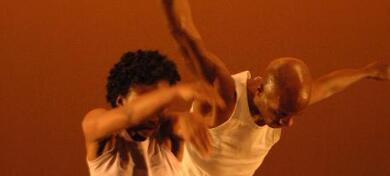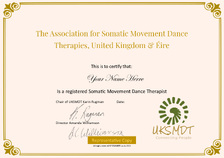

UKSMDT scope of creative, theraputic and ethical practice
Somatic Movement Dance Therapists/Practitioners faciliate sessions within the following scope of practice
Sensory-perceptual motor expression
Facilitate awareness of the sensory-motor feedback loop (through sensing, feeling, perceiving, and moving consciously)
Support the development of sensory-perceptual movement awareness
Explore interoception, proprioception, gravi-ception, and kinaesthetic intelligence
Explore interoceptive awareness, reducing exteroceptive overwhelm, in order to ease the nervous system
Explore experiential anatomy and physiology, uniquely blending objective knowledge with subjective experience (first-person sensory-perceptual experience of the living body)
Facilitate a balance between resting (afferent sensing) and action (efferent motor expression)
Resting, releasing, easing and softening
Release and ease the myofascial tissues; supporting the reduction of sympathetic arousal, inviting parasympathetic release, softening tissue tonus and releasing emotional holding
Creatively explore the fluid nature of the human organism, supporting the free flow of fluids through tissues
Support breath awareness and cardio-ception (heart-sensing), inviting the vagus nerve into a state of health
Release restrictions, tension and stress in living tissues, via inviting free-flowing movement patterns, as well as supporting ease and fluidity through touch and bodywork
Support the fascia into a state of health, exploring bio-tensegrity
Use gravity as a fulcrum to reorganise myofascial pain
Movement fundamentals and development
Explore ontogenetic and phylogenetic developmental movement patterns
Explore somatic movement fundamentals such as: gravity, weight, mass, space, time, breath
Explore different rhythms, qualities, directions, energies, forces, and planes of action
Explore the differentiation and integration of body parts
Explore free-improvisation, supporting fascial fluidity, skeletal-muscular dexterity, spatial awareness and movement range
Explore movement polarities: parasympathetic/sympathetic, inspiration/expiration, up/down, high/low, left/right, direct/non-directional, inhalation and exhalation etc
Movement observation and analysis

Hands-on, Touch and bodywork
Teach anatomy and physiology through subjective experience and objective knowledge
Reconnect participants to their sensory-motor feedback loop
Enhance afferent sensing and conscious efferent motor expression
Bring awareness to living tissues and body systems that are often beneath consciousness
Support skeletal-muscular alignment
Balance asymmetries, releasing stress and strain, and supporting easeful posture
Support anatomical differentiation and movement integration
Support fascial release
Release habituated patterns of neuromuscular holding and support movement fluidity
Enhance moment-by-moment breath awareness and cardio-ception, reducing sympathetic arousal, and integrating mind and body
Calm and balance the nervous system (reduce sympathetic arousal and support parasympathetic ease)
Connect with Self, others, and the community group through the nonverbal language of touch, dance and movement
Support expressivity, creativity and the imagination-in-movement
Support imaginative sensory-perceptual movement pathways, inviting the embodied imagination to arise
|
Movement & the imagination |
Explore the relationship between sensation, emotion, image, symbol, impressions, and the embodied imagination
Explore the imagination-in-movement as the bridge to the soul: a unique process where unconscious contents can be integrated into symbolic form through imaginal expression
Work in a dyad, exploring the witness/mover container
Explore the transpersonal as a vital source of knowledge and connection
Offer a non-judgemental environment and heart-centred co-regularly space
Downlaodable Forms
We have added some guidlines for you to use. A new page will open, which will allow you to print, save or downlaod the documents at your leisure.
Guiding Scope of practice for Somatic Movement Dance Practitioners
Somatic Movement dance practices are uniquely crafted around the following approaches. Specialists tend to work
in groups, while therapists work one-on-one, and in groups. Registered SMDS adhere to the following health &
safety, ethical and practice-based guidelines.
Guiding Scope of creative practice for Somatic Movement Dance Therapists
Somatic Movement Dance Therapies (SMDT) are crafted and lensed through the areas outlined below. Registered SMDT’s adhere to the following Health & Safety and ethical guidelines. Specialists tend to work in groups, while therapists work one-on-one, and in groups.
Touch
Somatic Movement Dance Therapists ask their clients and participants to sign touch consent forms. These forms explain clearly why touch is used and delineate the type of touch practitioners use.
